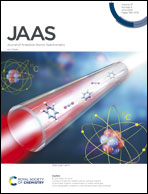A hybrid method combining discharge-assisted laser induced breakdown spectroscopy with wavelet transform for trace elemental analysis in liquid targets†
Abstract
Laser-induced breakdown spectroscopy (LIBS) represents a highly promising detection technology for the quantitative determination of trace elements in liquids. However, due to plasma fast quenching, liquid level instability, and limited laser-energy absorption, rapid real-time quantitative detection of trace elements with high-sensitivity in liquid targets remains significantly challenging. Here, a feasible hybrid method of discharge-assisted laser-induced breakdown spectroscopy (D-LIBS) with wavelet transform de-noising (WTDN) was proposed for trace metal element analysis in oil pollutants. Compared to conventional laser-induced breakdown spectroscopy (C-LIBS), this method has the capacity to increase signal intensities of trace metal elements by one order of magnitude. For the Ca element, the signal to noise ratio (SNR) is increased by 16-fold with the optimal wavelet basis and decomposition layer in WTDN. Examining the LoDs of Al, Ba, Ca, Cr, Fe, Na, and Zn shows that D-LIBS with WTDN allows the LoDs to be lowered to 1/2–1/24 of the original level. And the LoDs of Ca and Ba are measured to be as low as 0.32 mg L−1 and 0.69 mg L−1, respectively, which are reduced by one order of magnitude compared to those of C-LIBS. Moreover, the standard addition method analyzed the recoveries of Ba and Fe elements in the real samples of spiked lubricating oils to evaluate the method’s trueness. Superior accuracy and repeatability are obtained by D-LIBS, and the mean recoveries are in the range of 101.81–105.45%. In addition, partial least squares regression (PLSR) and support vector regression (SVR) models were established to predict the metal concentration. Thanks to this hybrid method, the PLSR model allows the coefficient of determination (RP2) to increase from 0.4710 to 0.9250, and the SVR model allows the RP2 to increase from 0.4590 to 0.9876. Our work provides an alternative, economical, and reliable method for rapid real-time quantitative analysis of trace metal elements with high-sensitivity in various industrial applications associated with oil pollutants.



 Please wait while we load your content...
Please wait while we load your content...